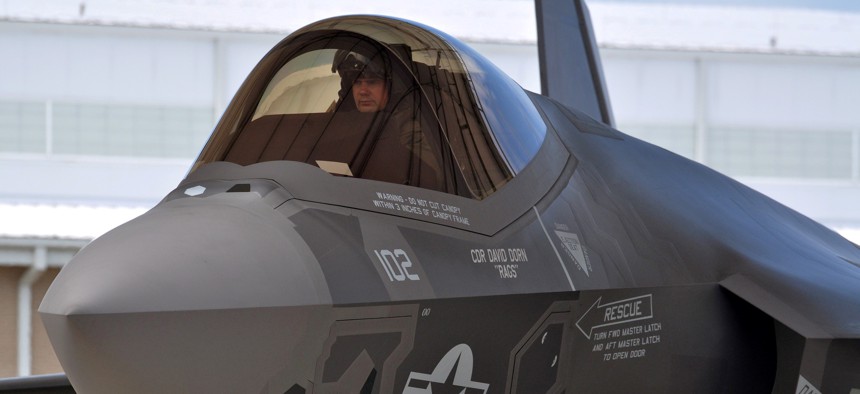
Navy Lt. Cmdr. Christopher Tabert lands his F-35C Lightning II in 2013 at Eglin Air Force Base, Fla. Staff Sgt. Nicholas Egebrecht /U.S. Air Force
F-35 Chief: Think Very, Very Hard Before Making Another Joint Fighter
Lt. Gen. Chris Bogdan has a bit of advice for Air Force and Navy leaders envisioning their next tactical aircraft.
Perhaps the only thing U.S. military leaders know about their next fighter jet is this: they want the program to go better than the F-35’s did.
The sixth-generation fighter effort is still in its infancy; the aircraft it produces may not fly for decades. The Pentagon hasn’t even decided whether to build separate planes for the Navy and Air Force. But the services’ leaders are already cooperating to figure out how the futuristic fighter will fit into the battlefield of the future — and how they can avoid another tactical aircraft program that winds up so late, over budget, and short of its goals.
Ask the F-35 program’s current director for advice, and you’ll get this gentle warning: joint programs are hard.
“I’m not saying they’re bad. I’m not saying they’re good. I’m just saying they’re hard,” Air Force Lt. Gen. Christopher Bogdan said Thursday. “You ought to think really hard about what you really need out of the sixth-generation fighter and how much overlap is there between what the Navy and the Air Force really need.”
When the F-35 was conceived in the 1990s, the goal was to buy a common plane for the Air Force, Navy, Marine Corps, and even America’s allies. The Air Force version would fly from traditional runways, the Navy version would operate from aircraft carriers, and the Marine version would be built to take off from short runways and land vertically. The goal was to have all three have 70 percent of their parts in common, which was meant to save billions of dollars in development and logistics costs.
But engineering changes have produced three variants that have only 20 percent of their parts in common, Bogdan said at a conference sponsored by McAleese and Associates and Credit Suisse.
If Pentagon leaders do choose to build a multi-variant plane to serve multiple sets of requirements, he said, the services will have to embrace compromise to a greater degree than happened in the $400 billion F-35 program.
“Man, is [compromise] a hard thing to do when you’re spending billions of dollars,” he said. “You want what you want, [but] hopefully get what you need.”
And indeed, some top military leaders are hinting that another joint, F-35-like project is not in the works.
“We will have some different requirements for what we need based on the different things we are expected to provide for the joint force,” Lt. Gen. James “Mike” Holmes, Air Force deputy chief of staff for plans and requirements, told reporters last month. “We will use common technologies and maybe some common things, but at this point we think it will be a different enough mission that it won’t be the same airplane.”
Asked Thursday whether the Navy would work with the Air Force to buy a new sixth-generation aircraft, Adm. John Richardson, the chief of naval operations, said, “It’s really too early to make a conclusive statement in that regard.”
Richardson said the two services, which are already discussing the key capabilities of a fighter that might first see combat in the 2030s, will keep talking with one another.
“Even in the early stages, [the Navy is] committed to working with the Air Force on that so that we kind of learn from each other as effectively as we can,” the admiral said at the conference.
For now, Richardson said, the Navy is more focused on figuring out how to fly drones alongside manned aircraft on its aircraft carriers. “There’s just so much to learn about integrating unmanned aviation into the carrier air wing right now, but I just want to get started,” he said.
In the meantime, defense firms have been pitching concepts of their own for nearly a decade: planes armed with lasers, special engines that don’t give off heat, and more. Now if they can just come up with a way to help keep the program itself on track.




